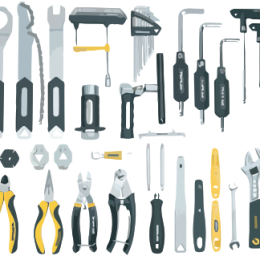Bicycling: Tips, Tools, and Techniques for Healthy and Safe Riding

38 Bicycle Tools for Any Repair Job
Even if you're just a recreational cyclist, chances are sooner or later you will need to do some minor repairs to your bike. It may not be convenient to take it to a bike …
Many people like to ride and since you're here, you probably do too. No doubt there are many positive aspects to cycling such as saving on transportation costs, eliminating parking fees, improving your physical health, and supporting mental health. And, of course, everyone likes the freedom and enjoyment of zipping down a hill! There just aren't many other activities that you start doing as a kid and can continue into retirement.
The bicycle has been with us from the very early 1800's with the first designs coming from Germany. The very first bicycles were made primarily of wood, with very little metal, and no rubber (e.g. tires). You might look at today's bikes and conclude that they're very simple devices, but they're quite sophisticated systems with very complicated components. Components have gone from being made of wood or very heavy steel to light and strong alloys. And advancement continues to this day. In fact, things have change so much that I have tools from just 10 years ago that are no longer compatible with today's bikes.
In fact, the first bicycles didn't even have pedals or a crank system. The rider propelled themselves, while seated, by ‘running.' Today, high tech drivetrains can offer up to 30 gears. There are also electronic shifting systems now available, decreasing the need for cables. With such systems, a rider simply presses a button on the lever, with the main advantage being very quick and accurate gear changes.
Over the years there have also been many attempts to alter the basic design of the bicycle. Some have caught on, such as the recumbent, while others have come and gone without much notice, such as having an overly large front wheel which. You now have many options to choose from.
Here's some trivia to impress bike riding buddies:
- The first bicycles weighed about 90 lbs (40 kg), while today's top of the line racing bikes are under 22 lbs (10 kg).
- In the U.S. alone the bike industry is worth $6 billion.
- About 100 million bicycles are manufactured worldwide each year.
- Most manufacturing now takes place in China. Shocking, I know.
- At this time, the most expensive bike is a Trek Butterfly Madone which has a price tag of$500,000. You'll want to get a good lock for this one!
- The most efficient frame material, in terms of strength and weight, is titanium. But it is too expensive for most riders.
- A bicycle, moving at about 7.5 miles/hours (12 km/hour), without a rider, will stay upright on its own. Riding without hands is easy!
- Contrary to popular belief, a lighter frame only makes a slight difference in attainable speed. Wheel weight, rider weight, ground friction, and aerodynamics are much more important.
-

Chronic Cycling Injuries: Heed the Warnings Or You'll Be Walking
-

The 4 Most Common Bicycle Frame Materials
-

Trick Out Your Bike for More Fun (and Safety) With Accessories
-

A Guide to Buying a Used Bicycle
-

11 Ways to Bike Ride Faster and Longer
-

Understanding Bicycle Braking Systems
-

Pedals and Cycling Shoes: These Shoes Were Made for Biking
-

Teach Your Child How To Ride a Bike
-

Dangerous Bicycle Repairs: You're Risking Life and Limb
-

Biking Essentials: What To Carry for Repairs and Safety
-

The Reasons Behind Why You Trail Other Cyclists
-

Need A Reason To Ride Your Bike?
-

Bicycle Chains: Everything You Need To Know
-

38 Bicycle Tools for Any Repair Job
-

Using the Right Torque For Bike Repair and Maintenance
-

Emergency Bicycle Repairs: Brilliant Ideas to Get You Out of a Jam
-

Drugs and Cheating in Professional Bicycle Racing
-

The Anatomy of Bicycle Wheels: Around and Around We Go!
-

9 Types of Bicycles: A Perfect Pick for Every Pedaler
-

Bicycle Gears: Often Poorly Understood Making For a Tougher Ride
-

How to Safely Ride Your Bike In Traffic
-

Calculating Your Optimum Cycling Cadence
-

Ride Your Bike Indoors Using a Turbo Trainer or Roller
-

Components: The Building Blocks of Every Bike
-

Maximizing Bike Rides To Lose Weight
-

Tires and Tubes: They Make the Bike Go Round
-

A Road Bike Fitting Will Maximize Performance and Comfort
-

14 Bicycling Mistakes: You're Guilty Of At Least One of These
-

Bicycle Cranksets and Chainrings: Round and Around We Go!


